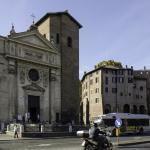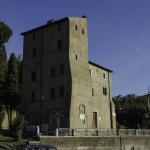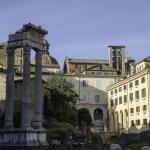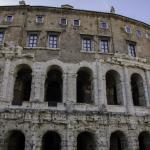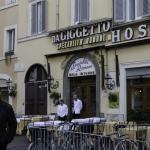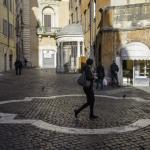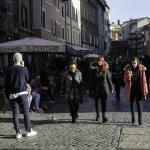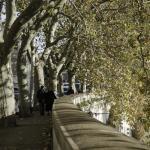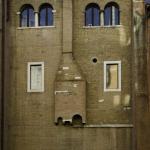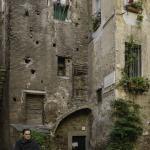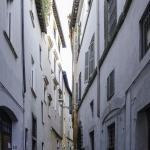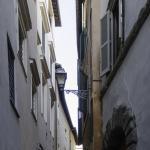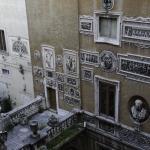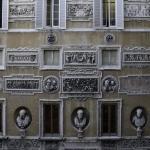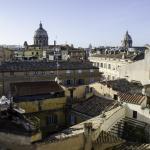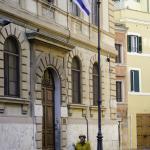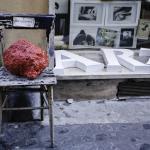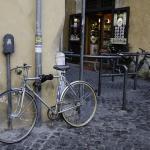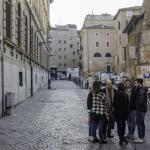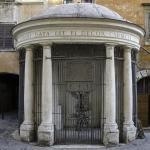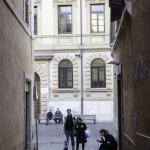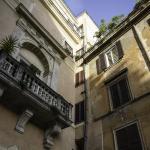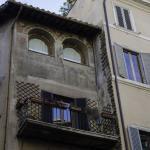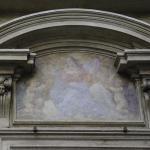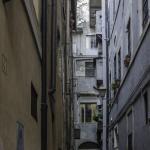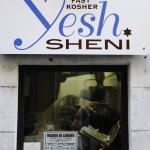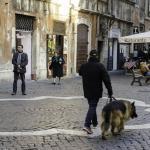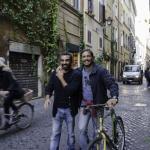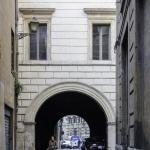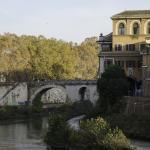Jewish Ghetto – a little slot on the banks of the river Tiber, an integral part of the 2,000+ year long Roman history, area, that has seen prosperity and decline of the Roman Empire and later through the centuries has blended into whatever the active ruling power had commanded, today proudly stands as a charismatic little quarter with its peculiar and grim past, only traces of which sparkle here and there like the rays of sun in the bubbling water of the fountain in Piazza delle Cinque Scòle.
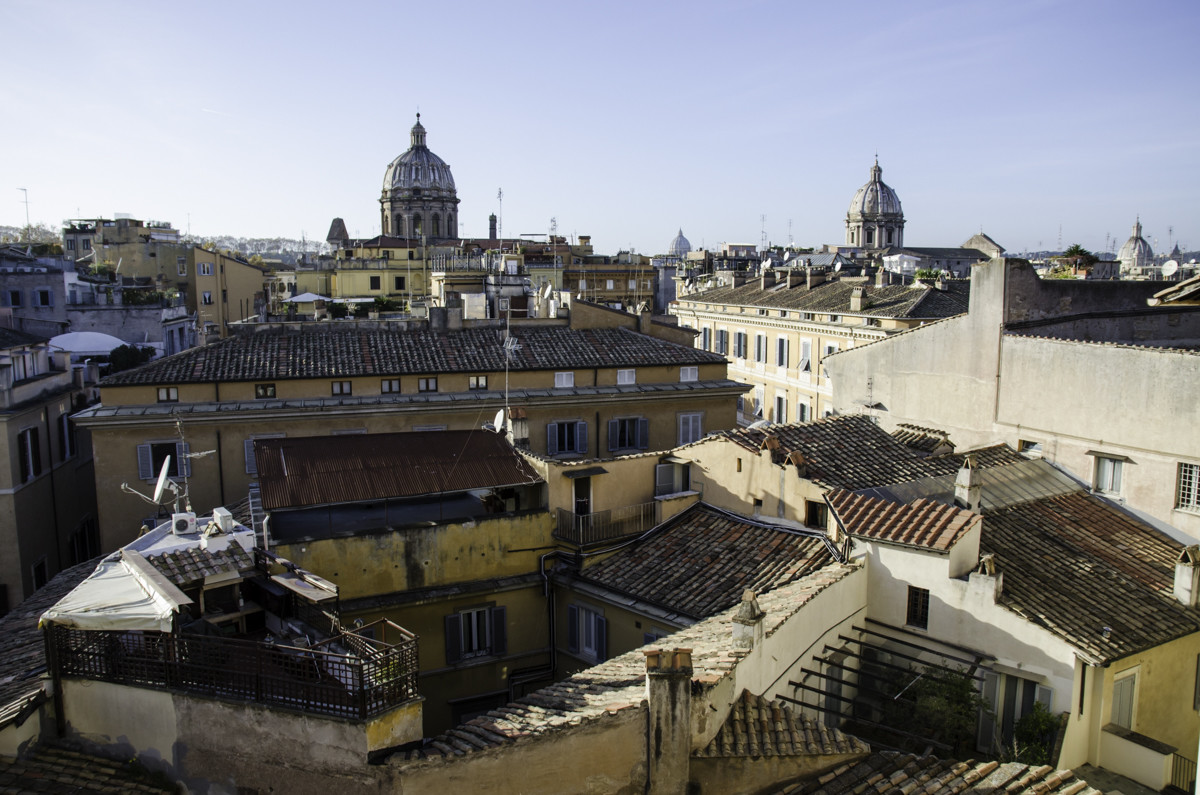
A short insight into the history of the Jewish Ghetto
The area that medieval ghetto has occupied in the middle Ages has been part of the Ancient Rome and was inhabited since before the Servian wall was built, as it was located just outside its western stretch. Since 3rd century BC it was mainly used as a monumental center devoted to dramatic performances, housing theaters of Marcellus and Balbus, as well as Circus Flaminius with its small race-track. The bridges connecting both sides of Tiber through the island in the middle, today known as Isola Tiberina, were constructed in the 1st century BC, thus increasing the importance of the neighboring area, where Jewish Ghetto quarter lies today. Approximately at the same time Emperor Augustus together with his step-father has enriched the area with two magnificent porticos, ruins of one of which are still preserved until our times.
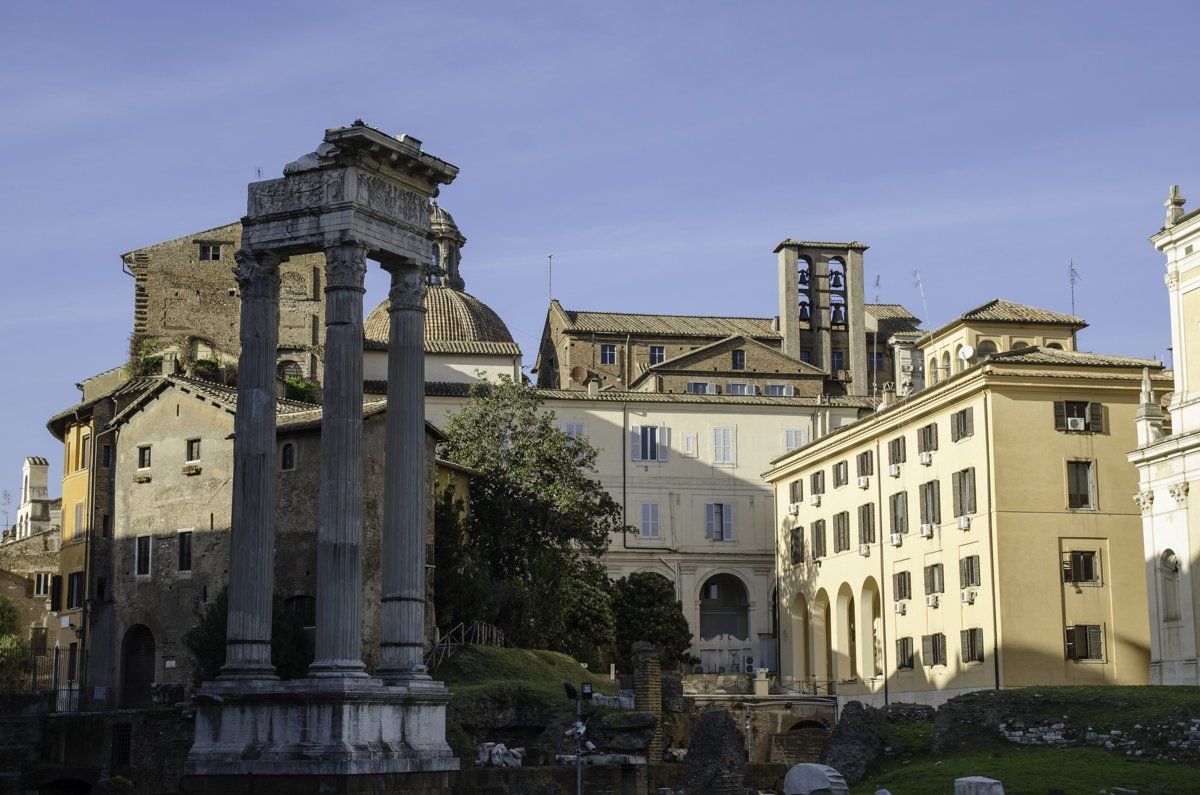
The records of the first Jews arriving to Rome date back to the 2nd century BC, and by the end of the 1st century AD the Roman Jewish community started to establish itself more firmly, mostly settling down as traders on the right bank of the Tiber together with other immigrants. After the fall of the Roman Empire and with the growing spread of Christianity, once the pope became literally the ruler of Rome, stricter limits were imposed on Jews and the way the community was treated varied from pope to pope. With the decline of the river trade in the beginning of the 15th century, Jews scattered through the city, many of them settling down in the Roman historical districts of Sant’Angelo, Ripa and Regola.
The influence of the ruling pope on the Roman Jewish community escalated in 1555, when Pope Paul IV revoked all rights that Jews had and created a ghetto, a walled restricted community where they had to reside. Roman Jewish Ghetto thus became on of the first ones in the world, following the first ever ghetto of Venice by only 40 years. The term ghetto itself is believed to be derived from that Venetian ghetto, from where it spread and acquired common use around the world. In the 16th century Venice, Jews were restricted to the area that also housed slag, a glass-like product which is left over from the metal production, and in Venetian dialect slag was called “gheto”.
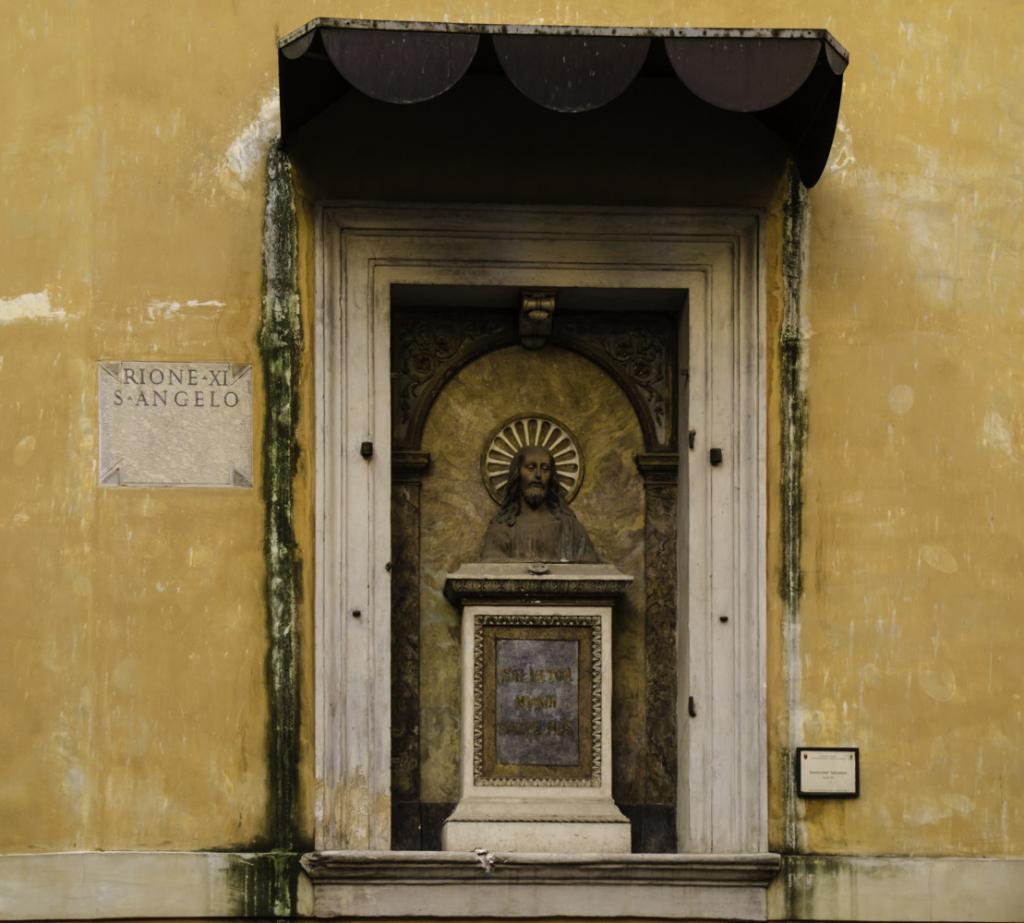
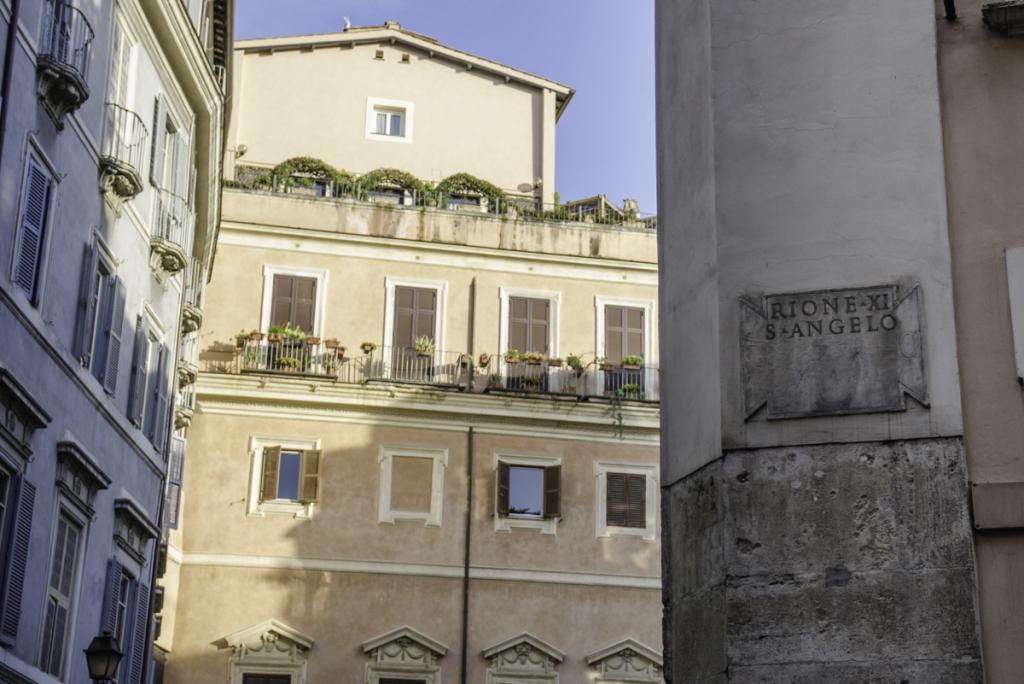
Roman Jewish Ghetto was placed in the area which already housed many Jews at the time – in the Sant’Angelo rione close to Tiber, and all the Jews residing elsewhere in Rome were pushed to move there. Undesirable due to frequent floods of the river, literally being just four little blocks of shaggy houses, ghetto was surrounded by wall that initially had only two gates, open at dawn and closed one or two hours after sunset depending on the time of the year. All the residents of the ghetto were restricted to stay in the area overnight and could go out only by day, when gates were open. Besides, when leaving the walled area, they had to wear a distinctive mark showing where they were coming from – a yellow veil for women or a piece of yellow cloth attached to the hat for men.
Several other humiliating restrictions were imposed, including the limit of possible occupations for the residents of the ghetto. They were only allowed unskilled jobs, such as fish mongers or second hand dealers. They were not permitted to own property and most of the houses in the ghetto belonged to roman Christians, who, however, could not change the rental rate or evict the occupants. Since the population was too big for such a small area, ghetto, not being able to expand outside the walls, started to grow up with the new floors being added to the houses, frequently having hidden connections between several apartments or buildings, which were not visible from outside. Hygienic conditions inside the ghetto were terrible as there was no running water until a few fountains were finally built by later popes. In 1656 during the Great Plague every 5th of the ghetto residents perished from the disease.
Jews had to pay taxes for both the construction of the wall around the ghetto, and for the permission to reside inside. Further humiliations included the order to swear loyalty to pope under the Arch of Titus, which commemorates the sacking of Jerusalem by Roman warriors. Rabbi had to pay yearly homage to the city counselors’ chief and in return received a kick to his bottom, which meant that Jews were allowed to stay in Rome for another year. On Jewish Sabbath residents of the ghetto were pushed to listen to the Catholic sermons in one of the churches around the area.
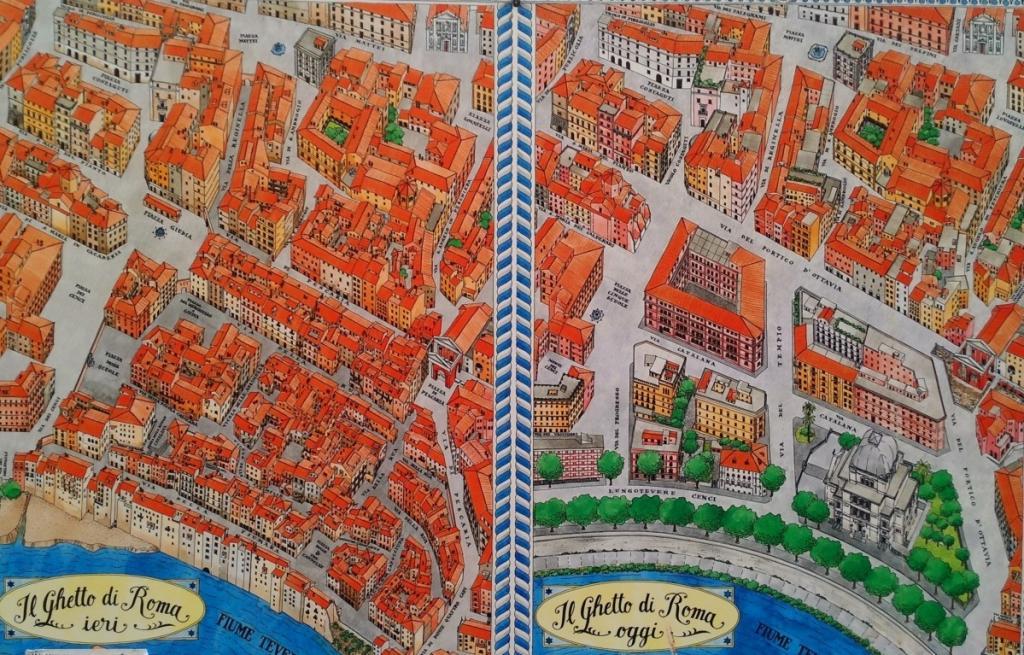
Ghetto borders were expanded twice, but just a few more blocks and other entrance/exit gates were added, first numbering 5 and then 8. The population of the walled area experienced a short-lived freedom first in 1798, when a general of Napoleon conquered Rome proclaiming the Roman Republic and annulled the requirement of Jews to live within the ghetto borders. However, already next year the papal power was restored and ghetto restrictions established once again. Another time the breath of fresh air came between 1848 and 1850, when the order to settle within the walls was lifted once again. The final freedom was achieved in 1870 under the first king of the united Italy, Victor Emmanuel II. At that time the history of the last remaining ghetto in Europe came to an end until the ghettos were reintroduced again by Nazi Germany in the 1930s.
The walls of the ghetto were completely demolished together with most of the shacks, as living conditions inside the walls were considered unacceptable: houses were heavily damaged by frequent flooding and by the neglect of the inhabitants, who were simple renters and not the owners, thus not caring much about the state of their homes. The best example of how the houses of ghetto looked like is only visible today near Portico of Octavia – a few medieval houses are built right next to it. As for the wall, the only little piece remaining was incorporated into one of the courtyard walls off the Piazza delle Cinque Scole. After the demolition of the ghetto, embankments were constructed on Tiber to prevent it from flooding the area, and Great Synagogue of Rome was built in 1904.
However, even with the walls torn down and Jews dispersed around the city of Rome, in 1943 another dreadful event once again revived the memories of the ghetto and put a bloody mark in its history. Rome was occupied by Nazi troops and they rounded up and deported to Auschwitz over a thousand members of Jewish community including the elderly, women and children, most of whom have never returned home. A plaque on one of the walls of the former ghetto commemorates this atrocious day.
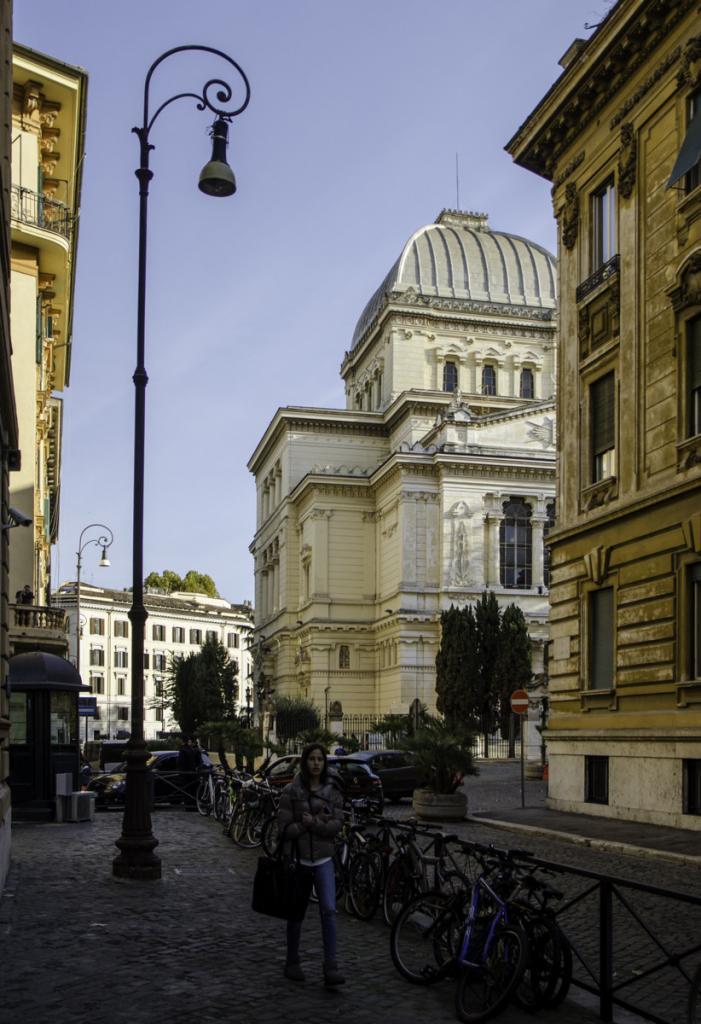
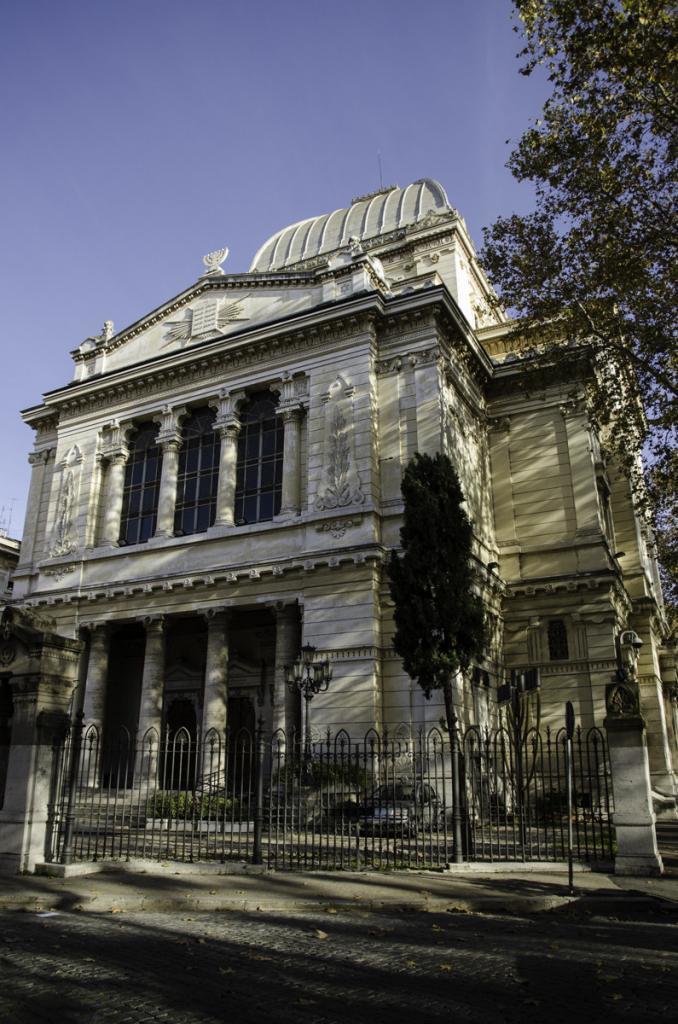
Thanks to the Great Synagogue Jewish Ghetto today is the center of religious, cultural and social life of the Roman Jewish community. On vibrant lively streets kosher restaurants with waiters wearing a kippah serve traditional dishes, one of which is very well known across the whole city – carciofi alla giudia, deep fried artichoke, is one of the best preserved and spread traditions of the Roman Jewish cuisine. Stroll along the narrow alleyways and lanes of the former ghetto, chat with friendly locals, catch the sounds of children liturgical singing through the open windows of the school, see the scars and marks of history left over the ages from Roman times up to modern days, and feel the true soul of this unique and distinctive Roman district. Read on to know what to see, where to eat and which things not to miss in Roman Jewish ghetto!
Most interesting sights in and around the Jewish Ghetto
Even though the area of the former Jewish ghetto covered only a couple of blocks, there is plenty to see and explore inside the once existing walls and in their immediate vicinity. Archaeological remains, Roman empire ruins, medieval buildings – all stand side to side for a careful observer and an inquiring eye. In this guide we would like to mention the most notable sights that will give you a deeper insight not only into the sombre story of Jewish ghetto, but also into the endless history of the Eternal city, one way or another connected with this remarkable area.
Surviving traces of the Ancient Rome
The area surrounding the medieval Jewish ghetto was in active use since the times of the Roman Republic. Bordering each other situated here were the following areas: Circus Flaminius – a large open area where games and races were conducted, Forum Holitorium – commercial marketplace for vegetable, herb and oil sellers, and Forum Boarium – a cattle market. During the 5th-1stcenturies BC the area was populated with notable buildings mostly of religious character, and some of the temples partially survive until modern days.
The Temple of Hercules Victor of a round Greek design dating from the 2nd century BC is the earliest surviving marble building in Rome. Located in Piazza Bocca della Verità, temple’s 19 out of 20 original columns and the wall built of travertine and marble blocks still stand today.
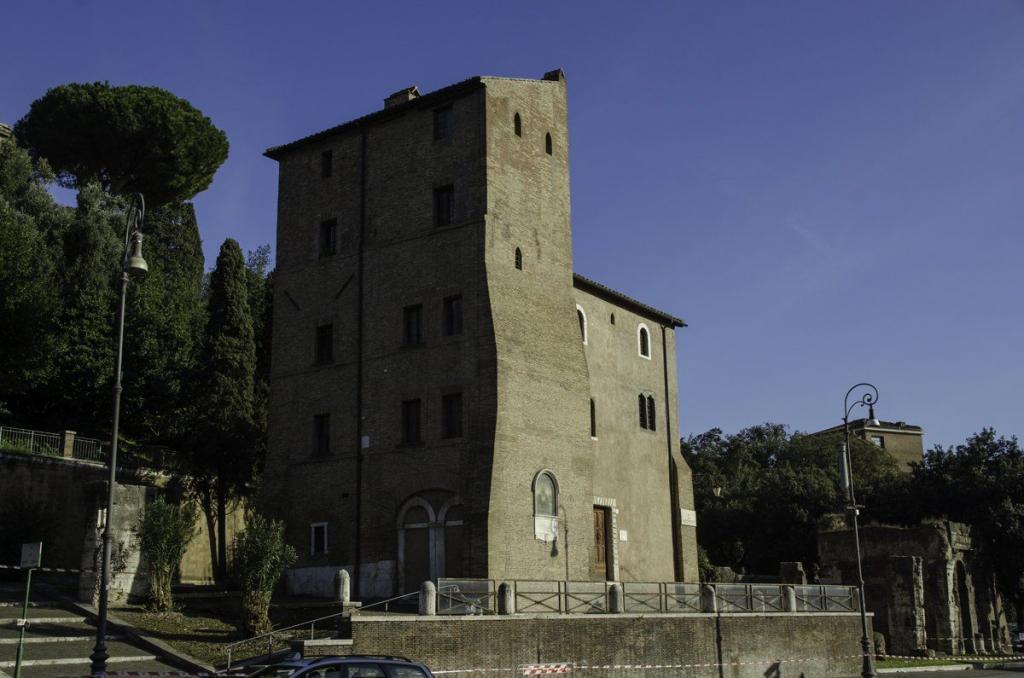
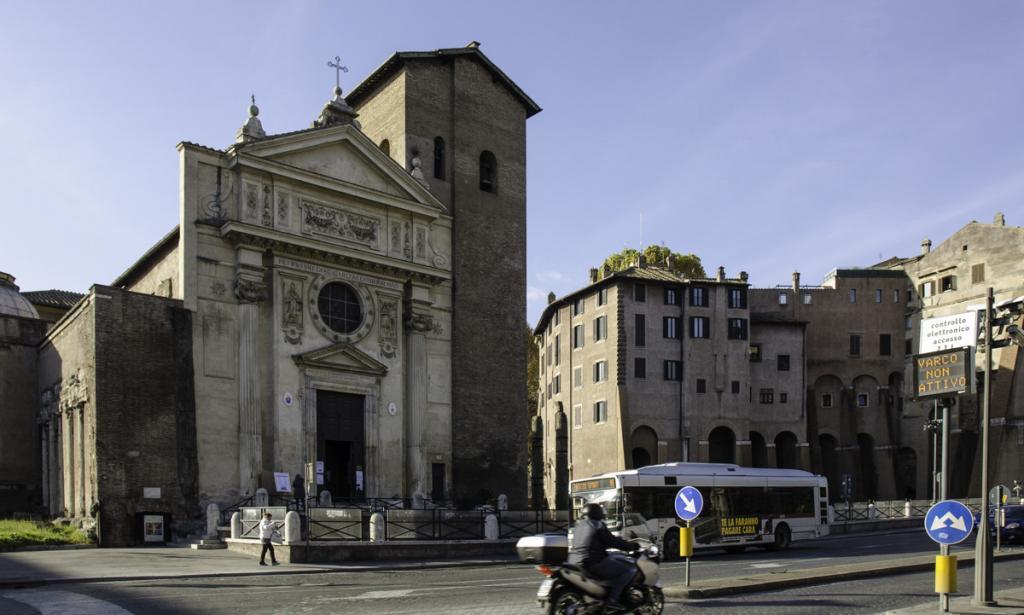
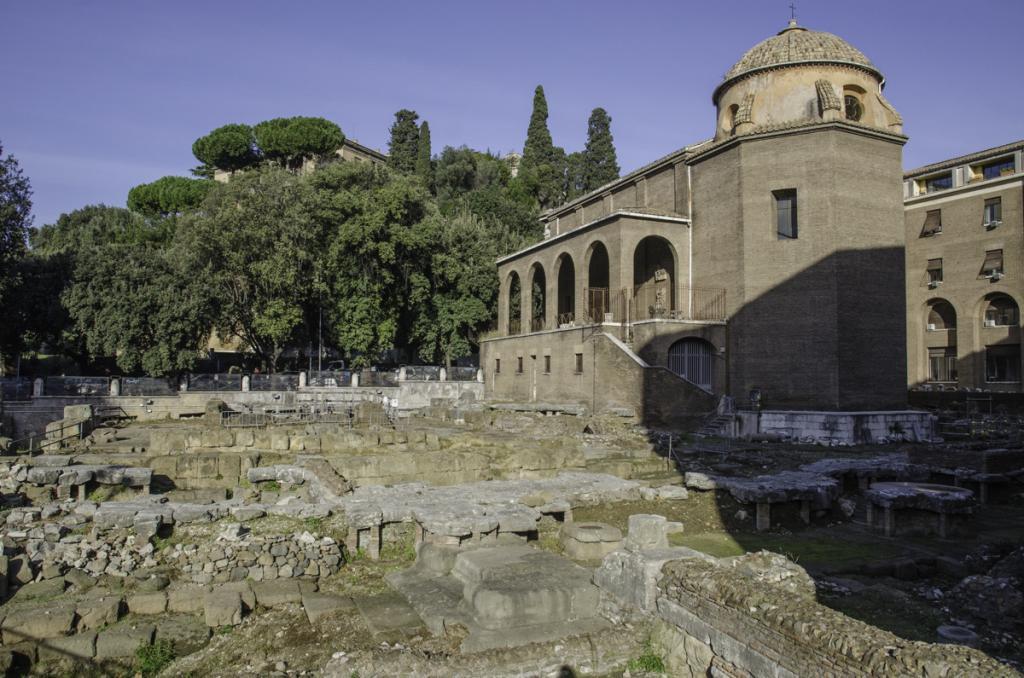
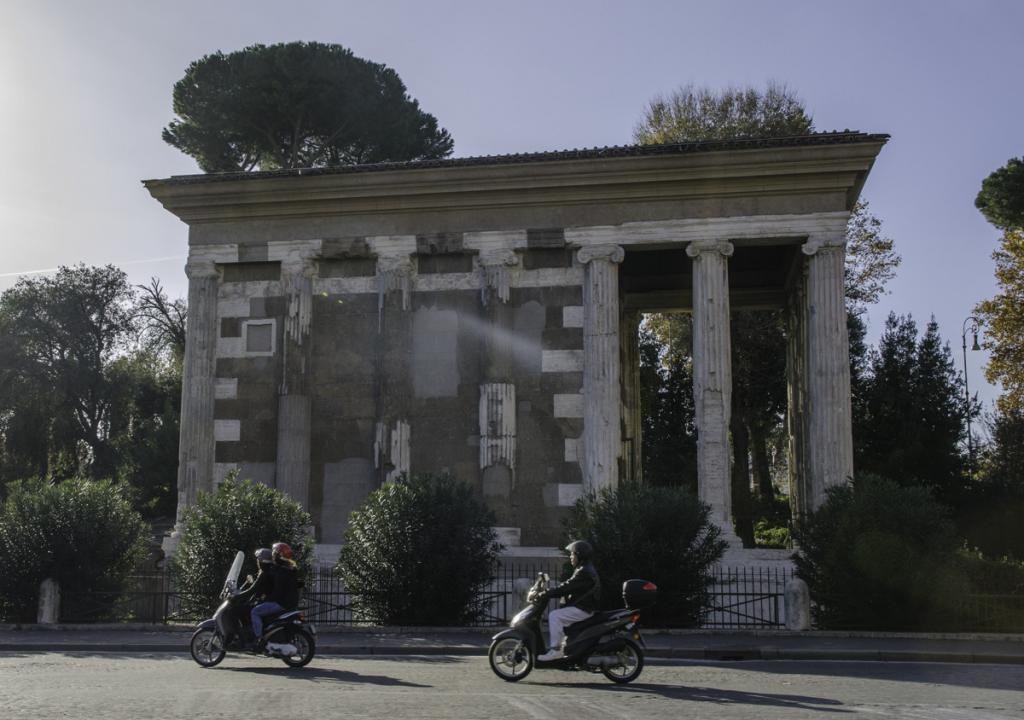
Another temple located just nearby, the Temple of Portunus built between 120-80 BC, is one of the earliest known examples of Romans using the concrete. Widely used construction material today, concrete was invented in the Ancient Rome and was utilized in the podium of the temple.
Continuing along Via Luigi Petroselli over what used to be an ancient marketplace, you will see a few other archaeological remains dating from the times of the Roman Republic. The Sant’Omobono Archaeological Area, located next to and under the church of the same name, contains the sites of the two archaic temples. On the other side of the road, the church of San Nicola in Carcere was constructed on top of the ruins of the ancient temples, columns of which are still visible today incorporated into the outside walls of the church.
Other sights from the period of the Roman Republic can be found along the river. Two banks of the Tiber are connected through the island with two bridges. One of them, Pons Fabricius, is the oldest Roman bridge in Rome which is not only still in use today, but has also retained its original state from 62BC, when it was constructed. Connecting the island with the other bank of the river is Pons Cestius, which was built sometime between 62 and 27 BC. Unfortunately this bridge has been reconstructed and lengthened several times, so only some of the original construction material is partially preserved in its structure.
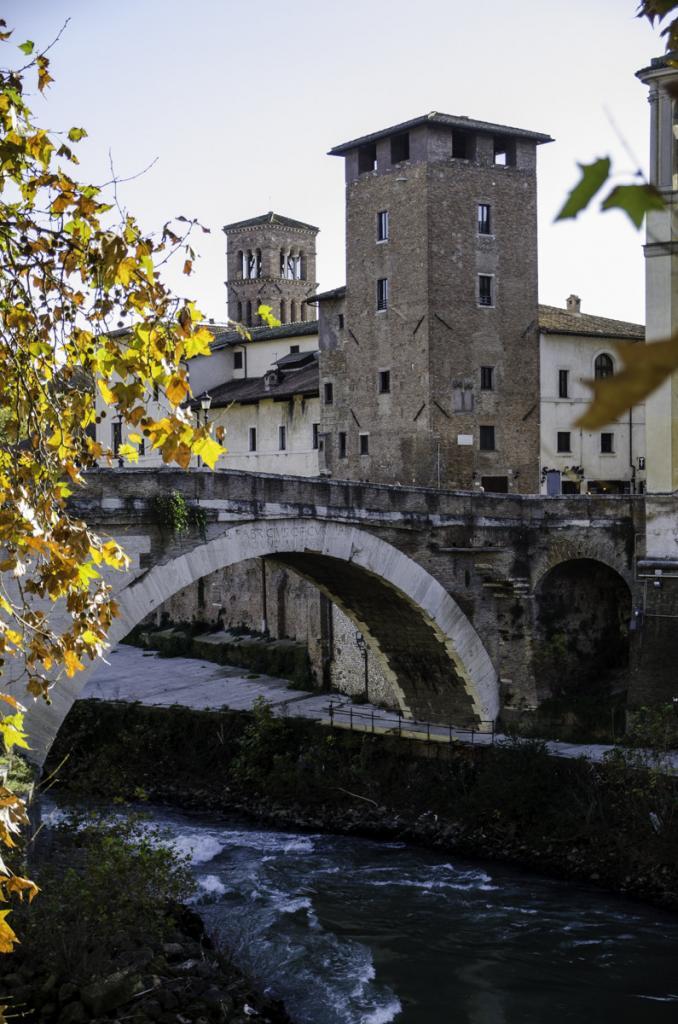
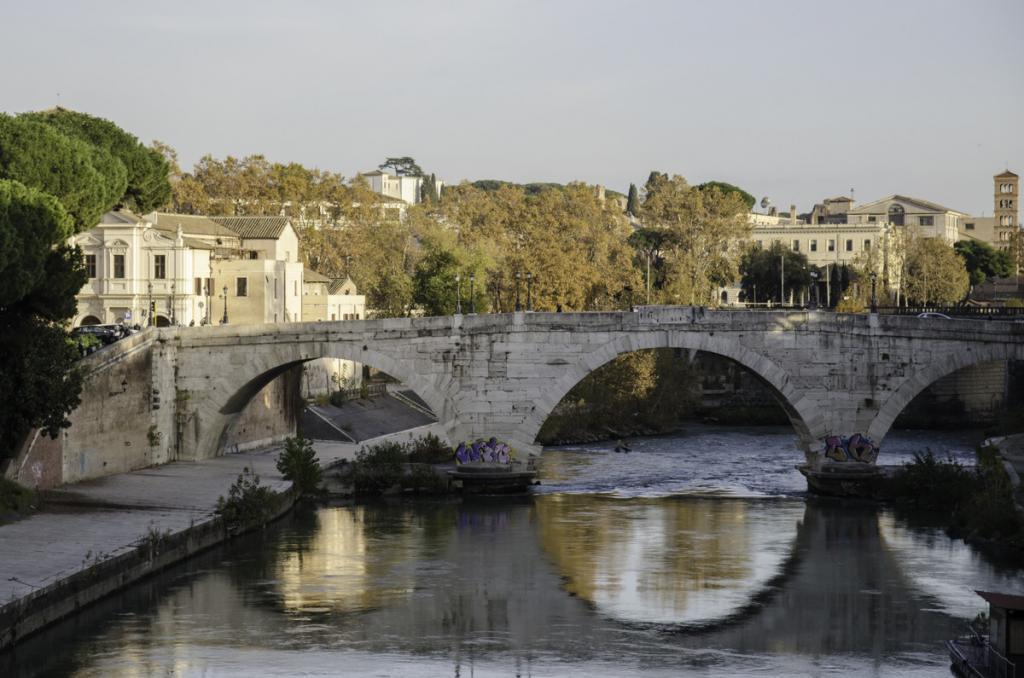
The oldest Roman stone bridge in the Italian capital, Pons Aemilius which dates from the 2nd century BC, is also located next to Tiber island. It is not in use any more as only the central out of the three arches that were previously connecting both banks of the river, remains standing today. However, its mouth, gaping over the Tiber, grinning with stone rubble, covered in plants, makes for a wonderful photo opportunity.
Another wonderful architectural example of the closing years of the Roman Republic is the Theatre of Marcellus. Largest and most important theatre in Ancient Rome, it could originally hold between 15,000 and 20,000 spectators and was 111 meters in diameter. Mainly used to please and bring under control the public during the electoral campaigns, it presented different plays and performances on its stage; benefiting from the location north-east of the Tiber Island, it also had openings through which the beautiful natural setting could be seen. Unfortunately, the Theatre fell out of use together with the decline of the Roman Empire by early 4th century AD, and some of its composing blocks, as it happened so frequently in the history of Rome, were used in construction of other structures, for example in reconstruction of the mentioned above bridge Pons Cestius. During medieval ages Theatre of Marcellus served as a fortress for several noble families, and in the 16th century the residence was built atop its ancient structure. Nowadays the upper floors are divided into multiple apartments, presenting the living testimony to the unimaginable twists and turns of the Roman history and its architectural marks.
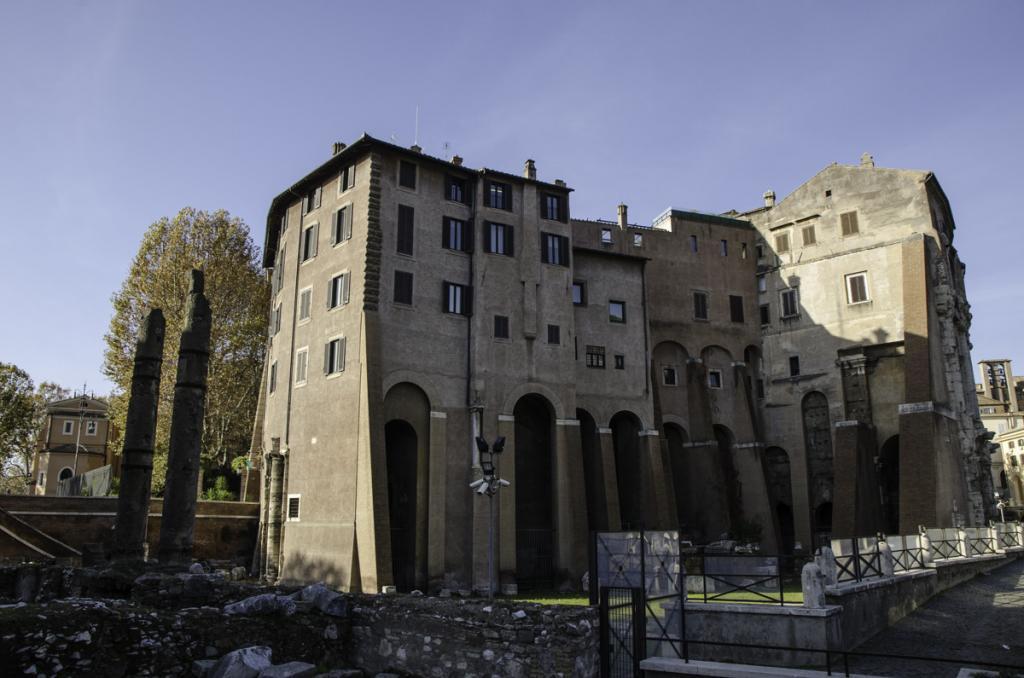
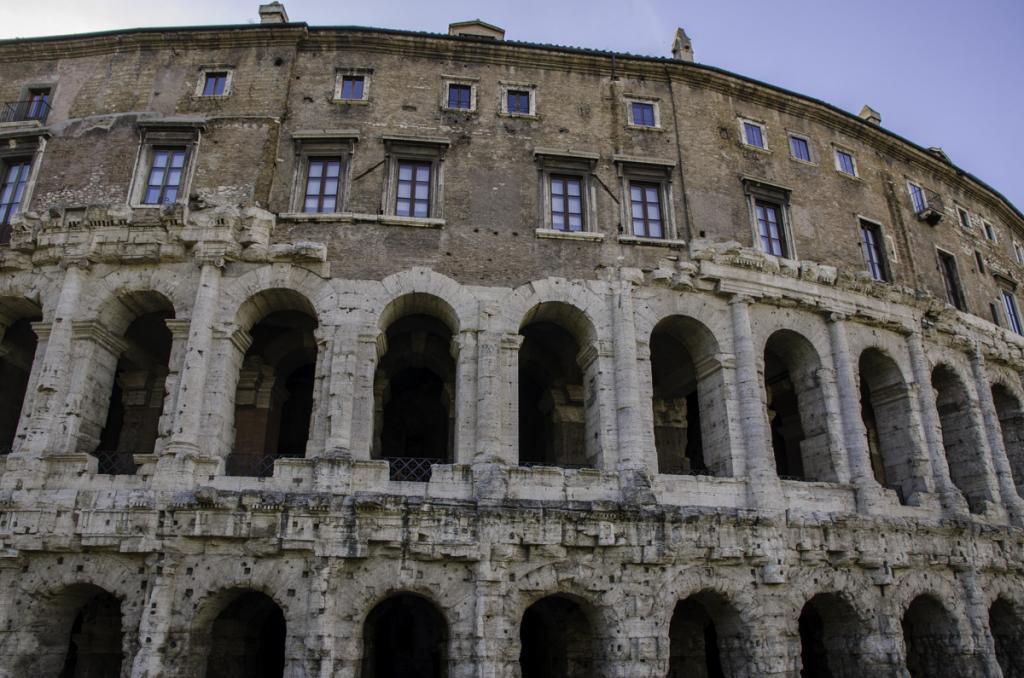
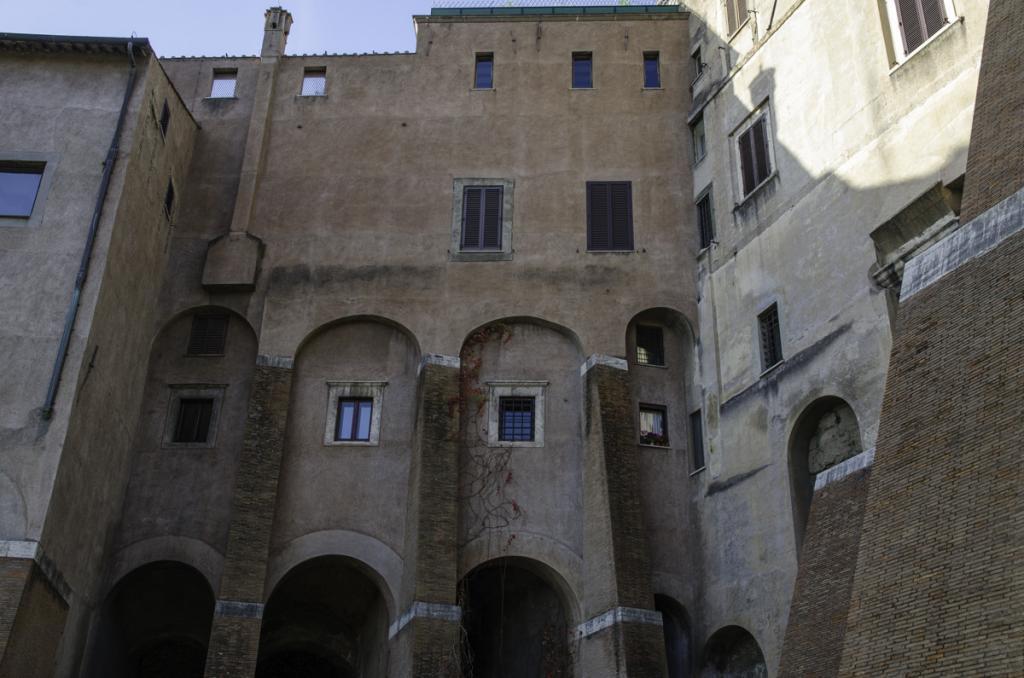
Located across from the Theatre of Marcellus is another structure from the early Roman Empire that has similar strange destiny with particularly “smelly” twist. The Portico of Octavia built by Emperor Augustus in honor of his sister, had beautiful colonnaded walls that enclosed two temples. Restored after two fires that caused extensive damage in the next few centuries after its construction, Portico was adorned with marble slabs and at some point even contained many famous works of art. After the earthquake in the middle of the 5th century AD two of the columns of the colonnadewere destroyed and subsequently replaced with the arch which survivesuntil today.
It was during the medieval ages when fish market was moved to the Portico of Octavia from its location besides the Roman Forum. Later becoming part of the ghetto, fish market stayed in place until the 19th century, and fish was sold over marble slabs of the Portico, repositioned and laid out along the street where they served both as tables and showcases.
The Middle Ages
Inside the former walls of the Jewish ghetto not much survives from the medieval times, as most of the buildings were demolished and rebuilt. However, right on the edge of the area there are some medieval palaces of noble families that are definitely worth a look.
Palaces of Italian Nobility
Through the Middle Ages and before the Unification of Italy in the 19th century, Italian peninsula was home to several different kingdoms and states. Noble Italian families frequently rose to power and prominence via judicial appointment, ecclesiastic promotion or election to the various regional senates.
One of the most powerful noble families of Rome which was also closely linked to the Jewish Ghetto is Mattei family. Roman Catholic in origin, they established themselves in politics and banking and were closely connected to the politics of the Church, to which the House of Mattei gave 8 cardinals. The Mattei family has moved to rione Sant’Angelo in the midde of the 14th century and eventually built a block of residences called the Insula Mattei, forming a kind of economical and residential “citadel”. When the wall was built around the Jewish Ghetto, the Mattei family was given a key to the gate. During the 15th-16th centuries many works of art were collected by the family and placed inside their palaces, many prominent architects and artists were invited to decorate the interiors. Today Insula Mattei forms the complex of cultural, artistic and architectural heritage and houses six valuable institutions, among which are The Library of the Modern and Contemporary History, the Center for American Studies, the cultural center and publishing house Istituto della Enciclopedia Italiana and others.
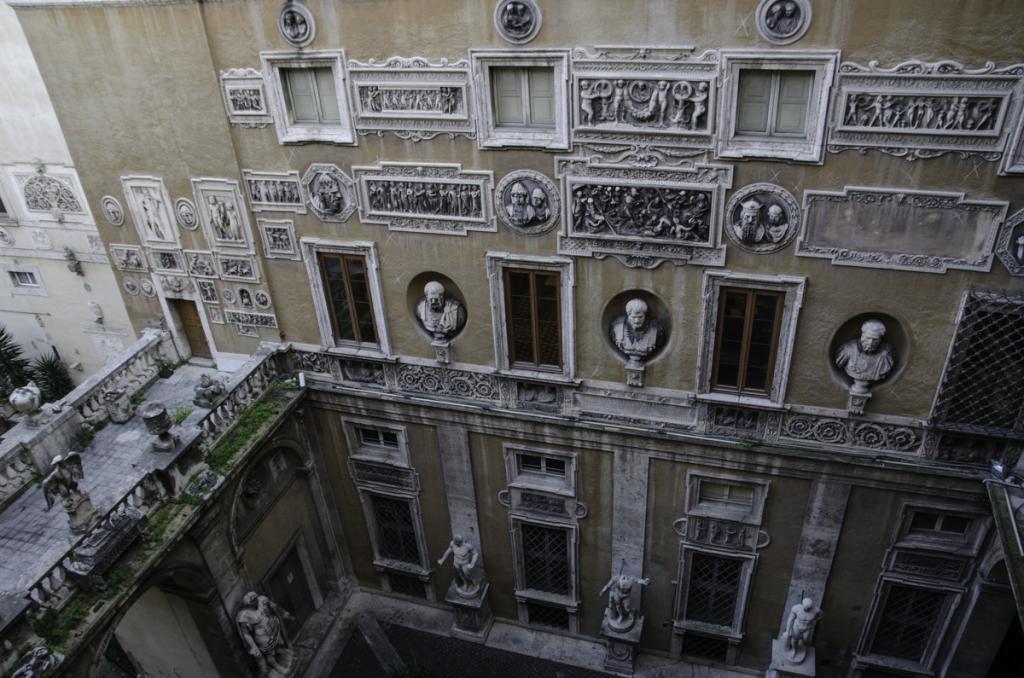
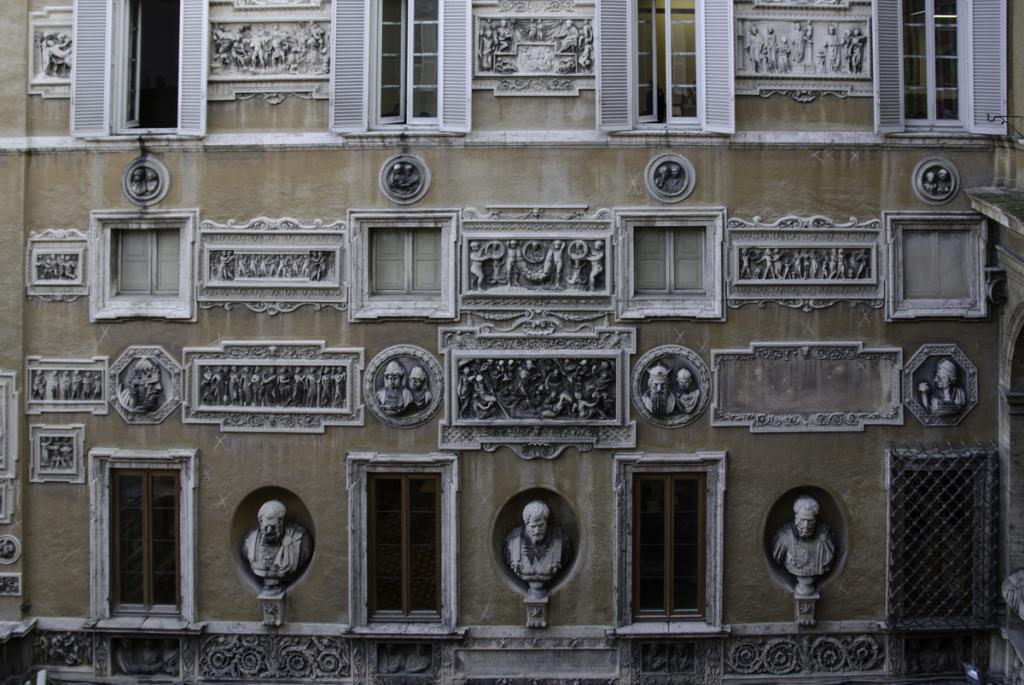
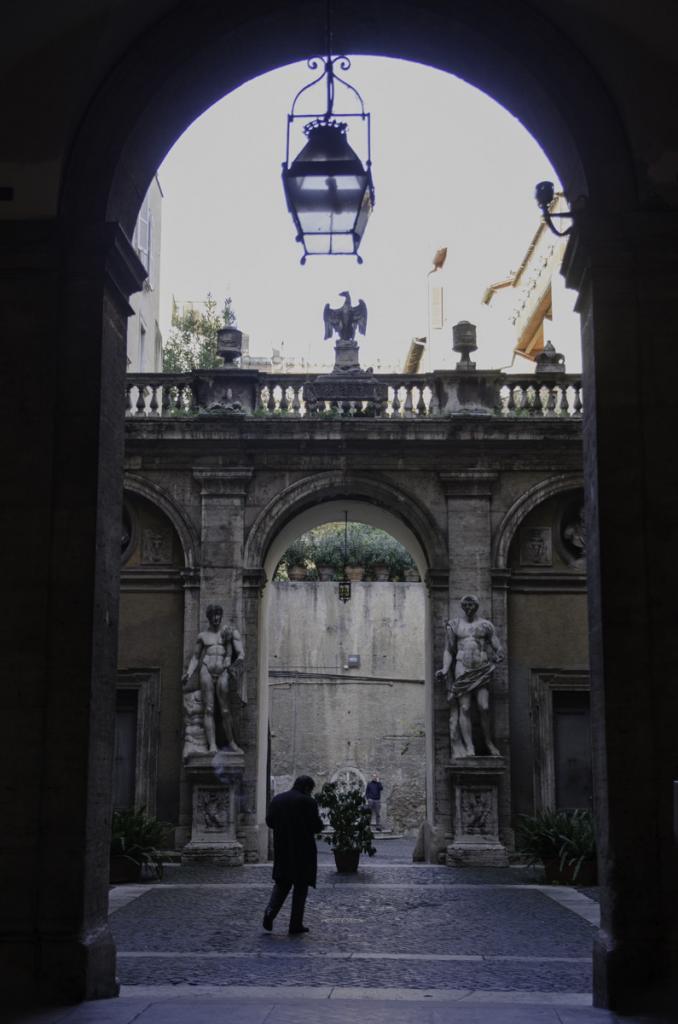
One of the most prominent and rich palaces of the Insula Mattei is Palazzo Mattei di Giove, designed by Carlo Maderno at the beginning of the 17th century. Pietro da Cortona has executed several compositions for the interior, and since many members of the Mattei family were enthusiastic patrons of the arts, Caravaggio is recorded to have lived in the palace in 1601. You can freely walk into the fantastically decorated inner courtyard from both Via dei Funari and Via Michelangelo Caetani.
Another interesting artistic object worth taking a look is The Turtle Fountain which is situated in the nearby Piazza Mattei. Like all Renaissance fountains, it was designed to supply drinking water to the population and according to the original plans was supposed to be placed inside the Jewish ghetto – at the site of the local market, Piazza Giudea, the square which does not exist today as it was demolished and reconstructed over at the time of the tearing down of the ghetto. However, a certain representative of the House of Mattei, Muzio Mattei, has used his influence to move the fountain towards his residence, agreeing to pay the costs of the maintenance of the fountain and to pave the surrounding square. Thus the Turtle Fountain is one of the few in Rome built not for a Pope, but for a private patron.
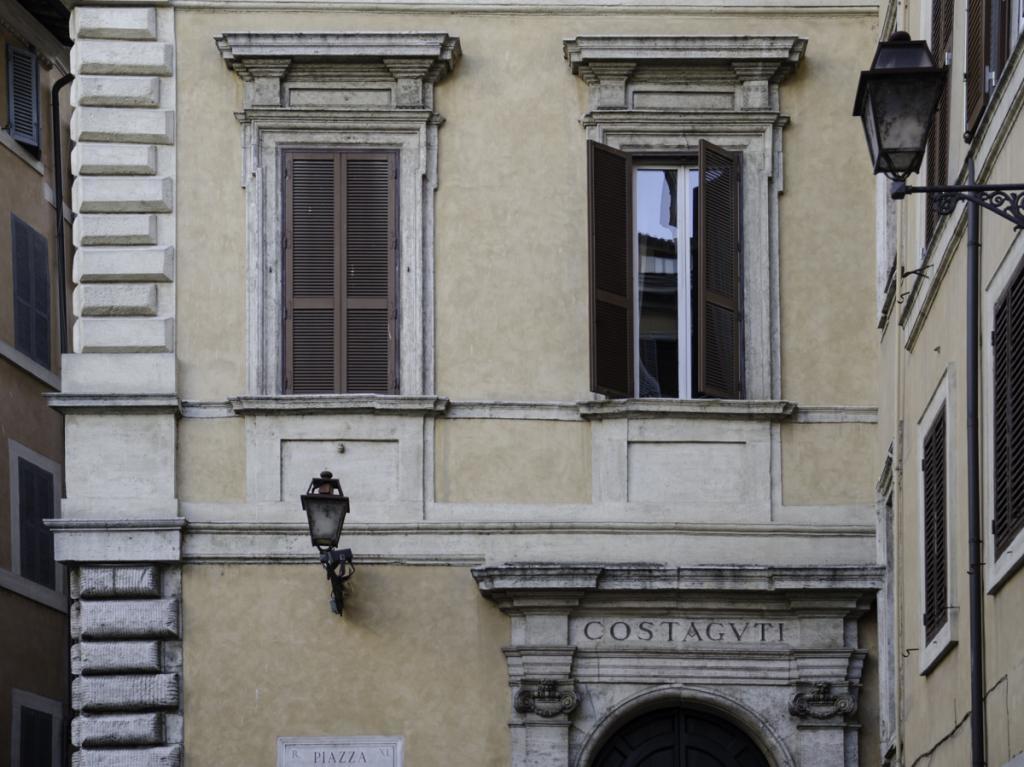
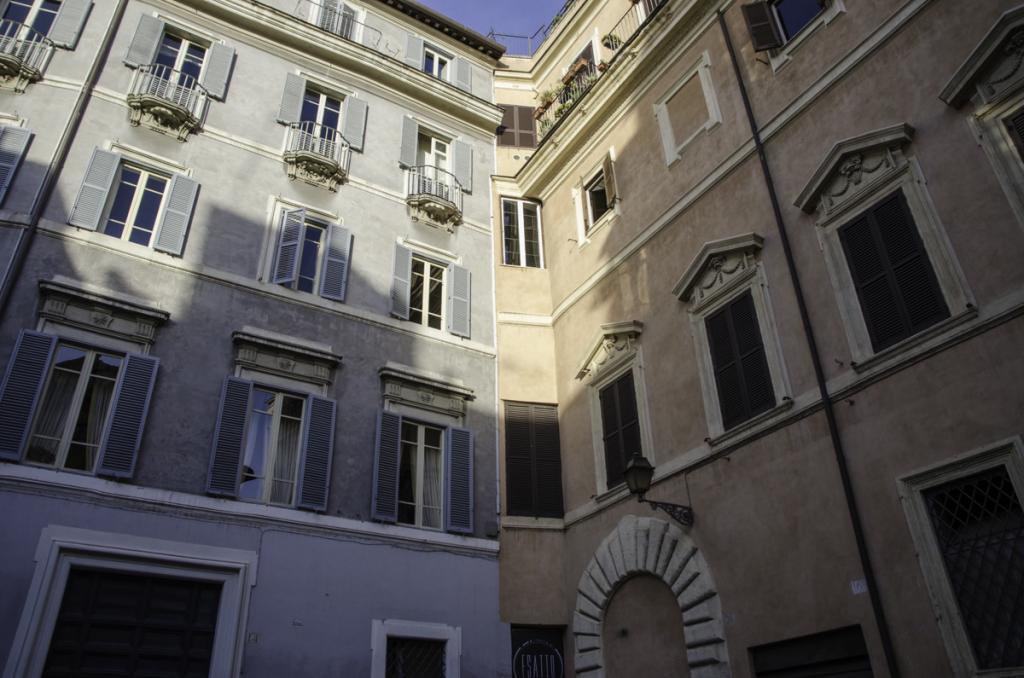
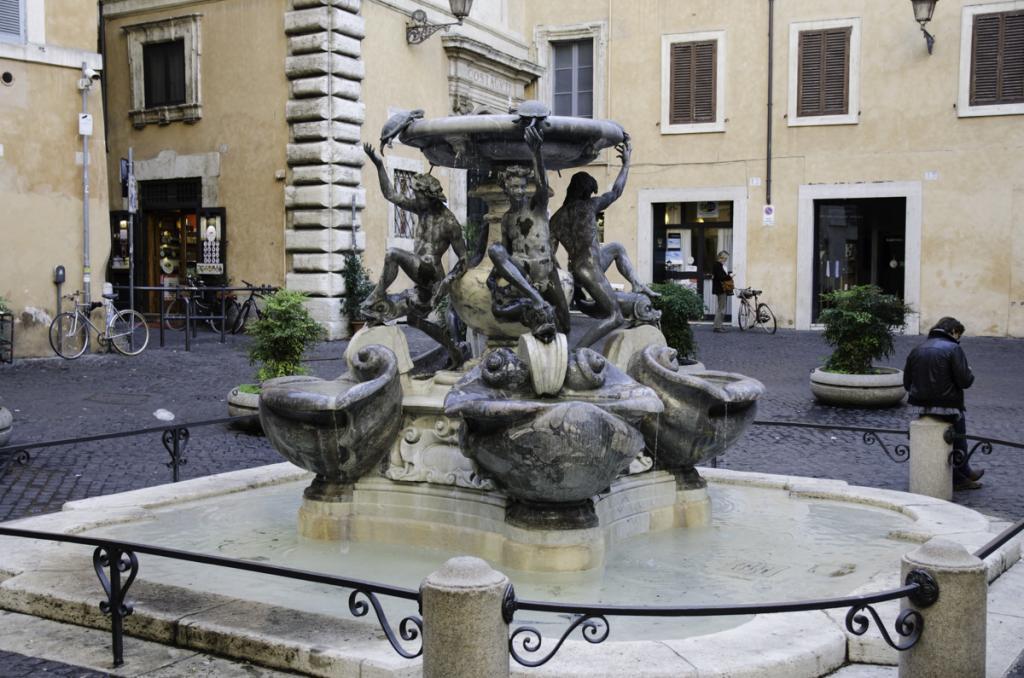
Continuing on to Piazza Costaguti you will find youself in front of the two other medieval palaces – Palazzo Costaguti, the facades of which are facing the squares of Costaguti and Mattei as well as Via della Reginella, and Palazzo Boccapaduli, both of them constructed in the 16th century. Palazzo Costaguti originally had its main entrance on Via della Reginella, but during the second enlargement of the ghetto that street was also included in its boundaries, so the main entrance was moved to Piazza Mattei and the former entrance was walled up. However, today you can still admire the old marble portal located between house numbers 29 and 30 on Via della Reginella, where instead of the old passageway now is only a window, covered with metal bars.
If from Piazza Costaguti you continue down the Via in Publicolis to where it intersects with Via di Santa Maria del Pianto, you will find another palace dated back to the early 16th century with a tower that stands right at the corner of the two streets. The inscription above the main entrance door still visible today tells us about the family of the founder, in whose honor the palace is called Palazzo Santacroce. This noble family has given Rome four cardinals, the first of which, besides other deeds, is remembered for the fact that he introduced the use of tobacco to the Italian capital, so that initially tobacco was even carrying the name of “Santacroce Herb”.
While exploring the narrow lanes of former Jewish Ghetto, pay attention to the block between Via della Reginella and Via di Sant’Ambrogio – this area was added to the walled ghetto last and nowadays you can still see here some remains of the characteristic medieval buildings.
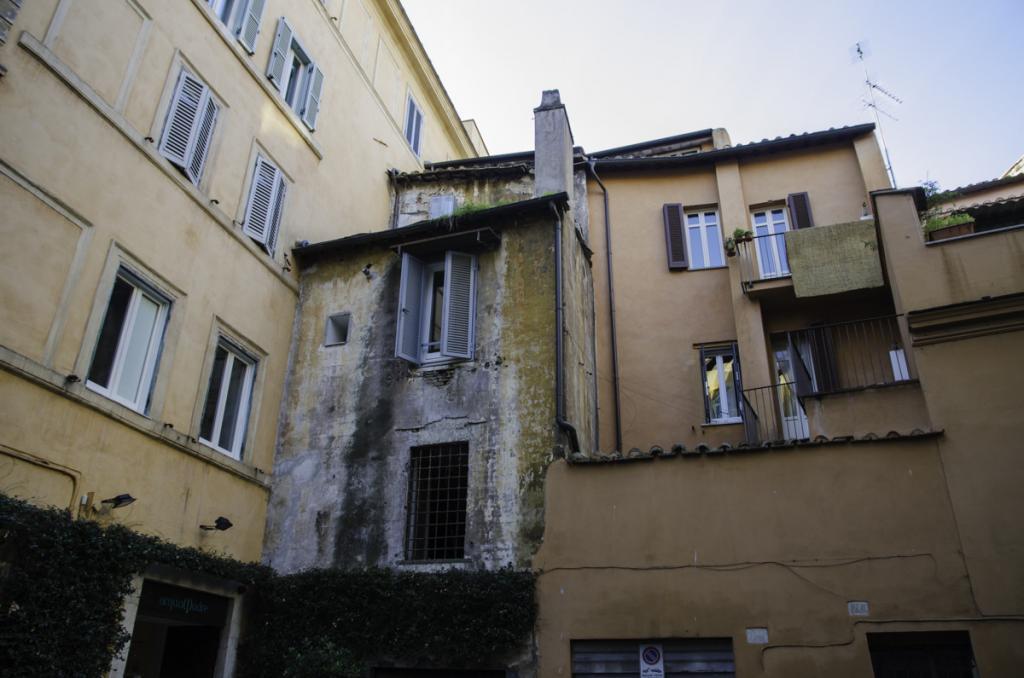
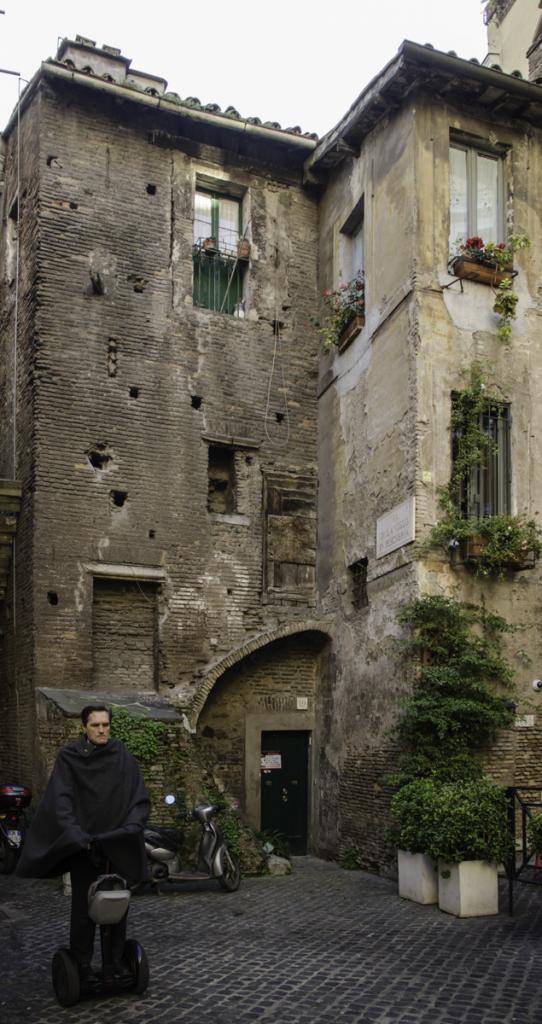
Religious Edifices
Located right next to the Portico of Octavia and borrowing some of its columns, the church of Sant’Angelo in Pescheria has also taken its name from the fish market (pescheria in Italian) which was located here in the medieval times. If the church is open, inside you can also find a fresco of Madonna with a child, which is attributed to Benozzo Gozzoli.
Next to the oldest Roman bridge, Pons Fabricius, another little church, San Gregorio della Divina Pietà, is located that bears the marks of the ghetto history. During the ghetto times it was here that Catholic sermons were held for the Jews on sabbath. Bilingual inscription in Latin and Hebrew above the entrance door still reminds of that fact today citing a passage from the Old Testament Book of Isaiah, in which the Lord complains about the obstinacy of the Jews.
Finally, the Great Synagogue of Rome, even though not built during medieval times, definitely represents a major part of the religious fabric of the district. Dating from the beginning of the 20th century, the Synagogue was designed and constructed in the eclectic style, giving it an exceptional look even in a city, that already has so many notable edifices and buildings. Its aluminum square dome is the only one of such shape in Rome, thus making the building easily recognizable from all the major panoramic view points. Inside the Synagogue you can find a highly recommended Jewish Museum or Rome, that has a magnificent collection dating back to the years of the Ghetto, which includes over 400 silver objects, 900 textiles, 100 marble pieces, and diverse documents and parchments. Admission ticket to the museum (11€ for adults, 8€ for seniors over 65, 4€ for students) includes a guided tour of the Synagogue, available in English or Italian.
Food, Drinks And Other Services
As any other area of the historical center of Rome, Jewish Ghetto has plenty to offer for a hungry stomach. If you choose to stay here during your visit to Rome, we will also mention where you can find most of the useful services you could possibly require.
Restaurants with Table Service
A characteristic feature of the Roman Jewish cuisine is its fascinating blend of Italian and Jewish traditions and the history of the area. During the years of the Ghetto, Jewish families led very poor lives and had very little ingredients available for their daily staple, so resulting dishes were simple but nutritious, and thus successfully remained through the centuries as an integral part of the cuisine of the district. The two most well-known dishes, Jewish-style artichokes and fish broth, both stem from this fact. Artichokes were growing in abundance and were easily found, and one of the simplest ways to prepare them was deep frying. The fish market located on the edge of the ghetto was a wonderful source of the unwanted parts of fish, such as heads and tails, that were not sold and instead were just thrown out. Jewish women were collecting these remains, and since nothing else could be done with them, were boiling them to make the fish broth. Of course today the culinary traditions have developed and the dishes you can sample in the restaurants of the area use best ingredients and methods to prepare them, but with a modern approach and revaluation of the old traditions.
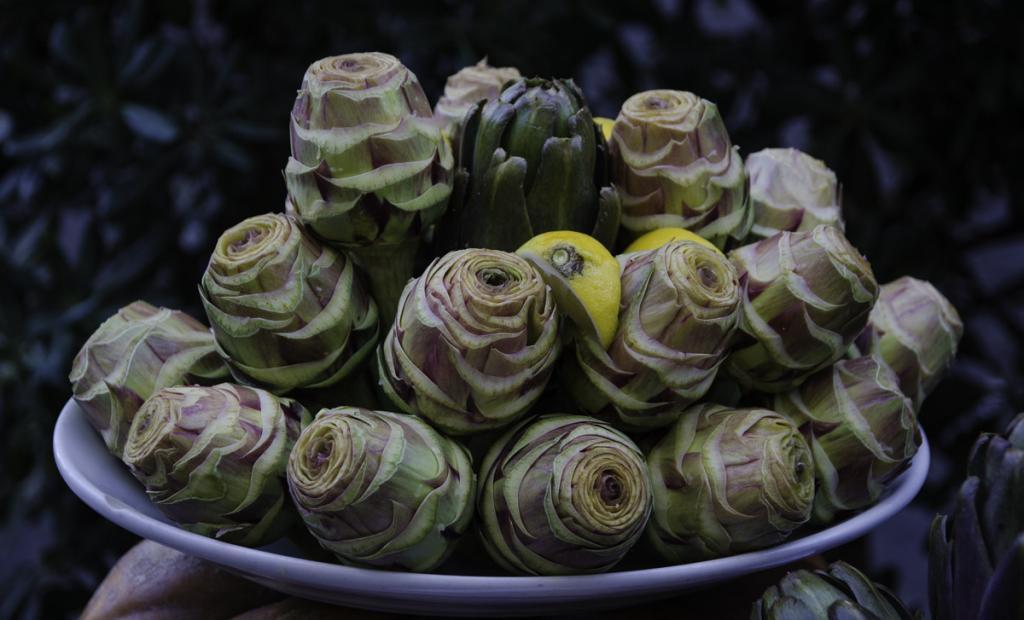
Best sit-down restaurants with extensive and kosher menus can be found along the Via del Portico d’Ottavia, and you can easily have a wonderful lunch or dinner here, no matter which place you choose from the list. It is always a good idea to reserve a table in advance, especially during weekends.
- Nonna Betta respecting the Judaic Talmud rule has two different menus, one for Meat and one for Fish and Cheese, as following the traditions of kosher cooking it is forbidden to eat or prepare dairy and meat together. You will find all the authentic dishes of Roman Jewish cuisine, as well as traditional Roman first and second courses with a characteristic twist. Walls covered by reproductions of colorful ghetto life create a special atmosphere and help to carry you back in time, and friendly staff will make sure your meal here will be enjoyable. Via del Portico d’Ottavia 16, +39 06 6880 6263. Open every day except Tuesday from 11:00 to 23:00.
- Ba’ Ghetto introduces another level of respecting the regulations of kashrut and has two separate locations situated down the street from each other. At Via del Portico D’Ottavia, 57 (+39 066 889 2868) you will find the restaurant that offers the meat menu, having only meat slaughtered under strict control, as well as selection of the dishes from the Middle East. It’s dairy counterpart located at Via del Portico D’Ottavia, 2/a (+39 06 6830 0077) has a wonderful selection of pizzas, cheese and fish dishes. Both restaurants are open every day from 12:00-15:00/18:00-23:00 and are only closed for Friday dinner and Saturday lunch to observe the Sabbath.
- La Taverna del Ghetto has an extensive menu for the satisfaction of any taste, which besides traditional dishes also includes the classics of most Roman restaurants, such as lasagna and steak. Extensive wine list is available to accompany your meal. Via Del Portico d’Ottavia, 8, +39 06 68809771, open from 12:00-23:00 every day besides Friday dinner and Saturday lunch.
Another restaurant in the area which serves traditional Roman cuisine and is worth noting for its long history is Sora Lella, which is located on the Tiberina island. The restaurant has been started in 1940 by the famous cook and actress Elena Fabrizi, known by her scenic nickname as Lella or Sora Lella, and has since hosted many famous actors and politicians. Authentic Roman food in a unique setting in the middle of Tiber, it’s a great choice if you are looking for a formal family dinner in best traditions of Roman cuisine. Open every day apart from Tuesday for both lunch and dinner (12:30-15:00/19:30-23:00), Via di Ponte Quattro Capi, 16, +39 06 6861601.
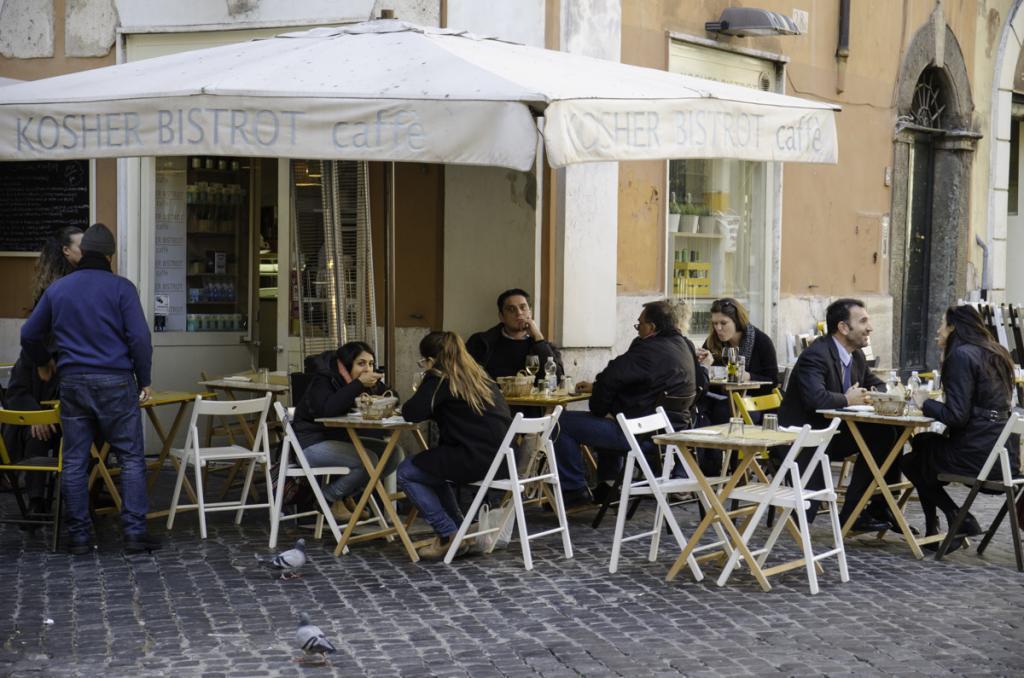
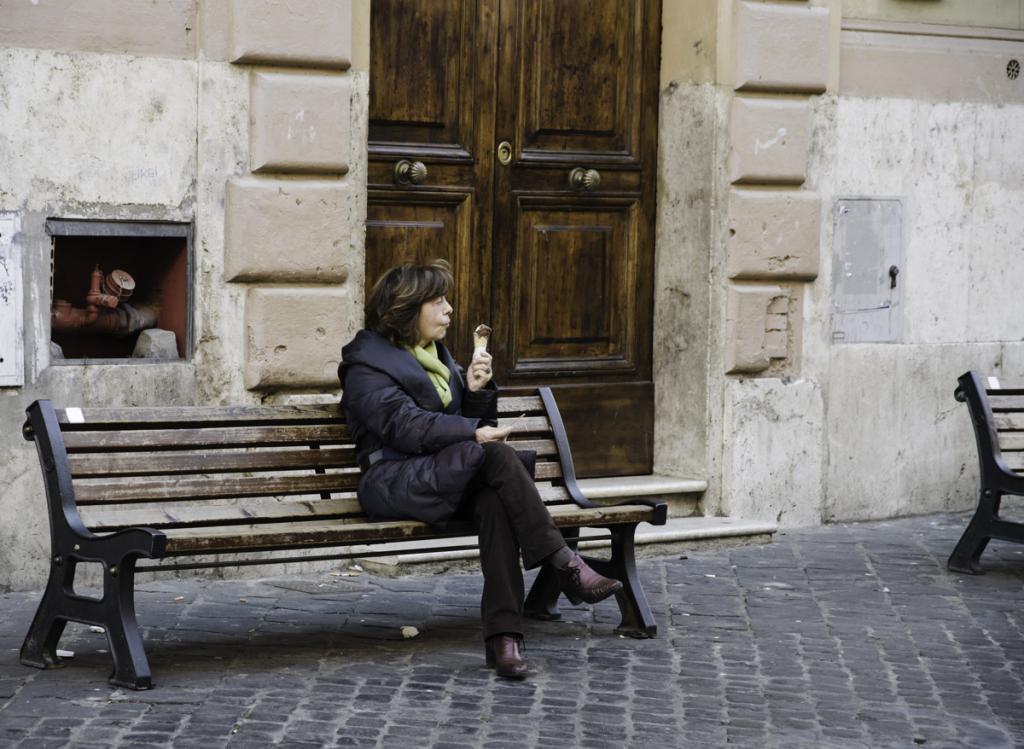
Quick Snack / Take Away / Desert
If you prefer to have a quick meal and continue with your Roman sightseeing program, or the weather is so wonderful outside you’d rather take your meal out on a bench and enjoy the sun, then there are plenty of little places, frequently with little or no seating, that however serve excellent and quick snack/lunch options.
- Fonzie – The Burger’s House is a good option for.. you guessed it – burgers, offering both vegetarian and meat options. As well as sandwiches, tortillas, bagels and salads, with a small selection of bottled artisanal beers. It gets very busy here during meal hours, so be prepared to wait if you can’t avoid the peak time. However, the food is prepared right in front of you very quickly – just pay at the cashier for your preferred menu item first and get a number which will be called out once your turn comes! There is also another room right next to the main one with extra seating. Via Santa Maria Del Pianto, 13, +39 06 68892029, open from Sunday to Thursday 10:30-23:30, Friday 10:30-16:00 and Saturday 17:30-00:00.
- Panepiu Bistrot is perfect for a quick bite as it serves prepared according to the authentic French recipe baguettes, filled with a selection of 20 different combinations of fresh high-quality ingredients. A few salads and deserts are also available. Via Florida 21, +39 06 4542 7800, open for lunch Monday to Sunday 11:30-15:30, and for dinner from Tuesday to Friday 19:00-21:30, as well as Saturday 19:00-00:00.
- Yesh Shenì is a fast kosher food restaurant offering shwarma and different street food, as well as some pasta dishes and meat courses. Via Santa Maria Del Pianto, 64-65, +39 06 6830 1198, Sunday to Monday from 10:00-23:30, Friday 10:00-15:30, Saturday 18:00-23:30.
- Dispensa Cibo Urbano, a little cafe where everyone sits at one long table, offers fresh choices buffet style with menu changing daily. If you are here off peak hours, you can enjoy great snack in a stylish setting. Via Paganica, 8, +39 06 6833853, Mon-Sun 09:00-22:00.
- Forno Il Boccione might look uninviting little hole with white walls and not always friendly old ladies over the counter, like if you caught them on a bad day, but the true gem lies in the produce of this bakery, not in its look or the first impression it gives you. Go past that and you will return here again and again for the pastry prepared according to the Jewish tradition. We highly recommend you the “Jewish pizza”, if you are lucky enough to get here on time before it’s sold out! Via del Portico D’Ottavia, 1, + 39 06 687 8637, open from Sunday to Thursday 07:00-19:00, Fridays 07:00-15:00, closed on Saturdays.
Supermarkets
Closest supermarket with decent selection of goods is located on Via Monte della Farina, 51 and is open from Monday to Saturday 08:00-20:30 and on Sunday 09:00-13:30. On Piazza della Enciclopedia Italiana, 52 you can also find a minimarket.
Farmacies
There are two farmacies located close to the Jewish Ghetto, both of them open Monday through Saturday from 08:30-19:30:
- Via Arenula 73
- Piazza Benedetto Cairoli 5
